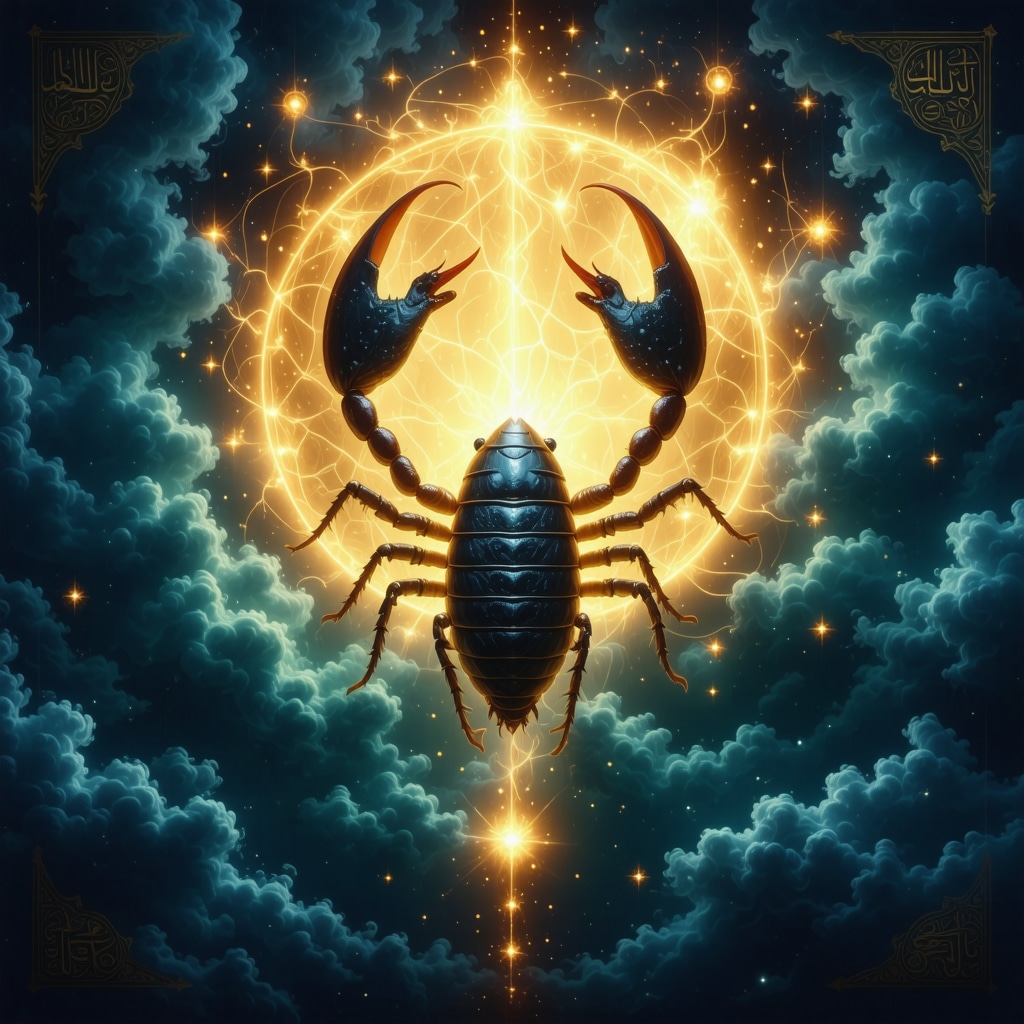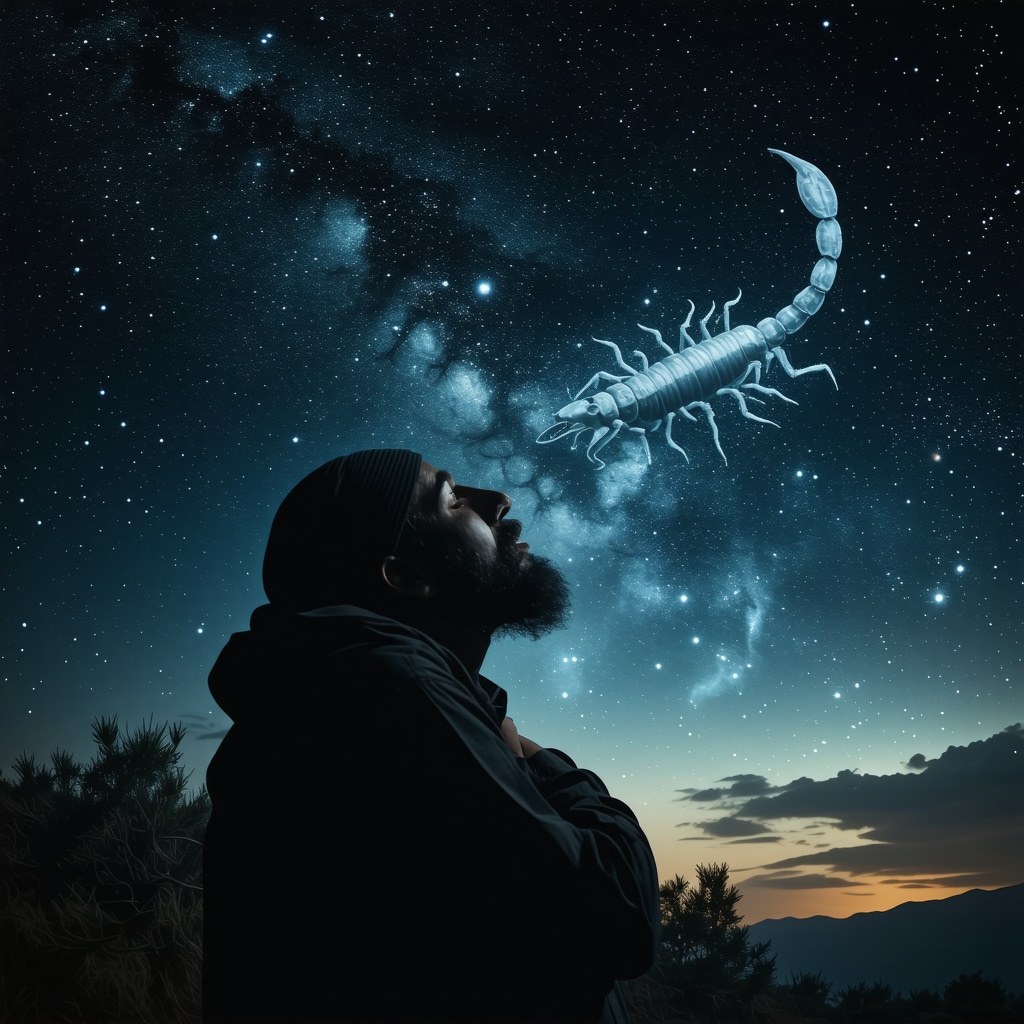My Unexpected Encounter with the Škorpiona in a Dream
There was this one night when I dreamt vividly about a škorpiona — a scorpion. It was not just any dream; it felt charged with meaning, almost as if it was trying to whisper a message. Being deeply curious about Islamic dream interpretations, I embarked on a journey to understand what dreaming of a škorpiona means in Islam. This personal quest was eye-opening, filled with reflections on symbolism, fear, and spiritual insight.
Decoding the Symbolism of the Škorpiona in Islamic Dream Traditions
In Islamic dream interpretation, animals often carry powerful symbolism. The škorpiona, with its venomous sting, generally represents hidden dangers, enemies, or challenges that one might face. When I read authoritative sources like Ibn Sirin’s interpretations, it became clear that dreaming of a škorpiona can signal warning signs about deceit or harm lurking nearby. But it also embodies resilience and protection in some contexts, reminding me that not every sting is meant to cause defeat; some awaken vigilance and spiritual strength.
How Does Islam View the Spiritual Meaning Behind Dreaming of a Škorpiona?
Islamic perspectives suggest that seeing a škorpiona in a dream often reflects inner struggles or external threats. It might be a call to safeguard oneself against malice or to confront fears courageously. Personally, this interpretation resonated deeply, as I was going through a phase of uncertainty and needed that nudge to stay alert and faithful. Interestingly, this aligns with broader Islamic dream symbolisms where animals like snakes or scorpions symbolize challenges but also spiritual trials leading to growth. For a richer understanding of animal symbolism in Islamic dreams, I found this Islamic dream dictionary on animal dreams very insightful and authoritative.
Reflecting on Personal Growth Through the Lens of Dream Interpretation
Dreams of škorpiona pushed me to introspect on the unseen tensions in my life and the importance of spiritual vigilance. It reminded me of the Islamic principle that trials, though painful, are pathways to purification and strength. Encountering the škorpiona in my dream was like being given a spiritual compass—a call to balance caution with trust in Allah’s protection. This dream also encouraged me to explore related symbols, such as snakes, which share similar meanings in Islamic dream literature, providing a comprehensive view on how animals communicate messages in our subconscious.
If you have ever dreamt of a škorpiona or other animals and felt puzzled by their meaning, I invite you to share your experiences or questions in the comments below. Exploring these dreams together enriches our understanding and personal growth.
For those interested in diving deeper into Islamic dream symbolism, particularly about animals, I highly recommend visiting this detailed Islamic dream dictionary on animals. It helped me connect many dots during my dream interpretation journey.
Exploring the Nuances of Škorpiona’s Symbolism Beyond Fear and Danger
While the škorpiona often symbolizes danger or hidden enemies in Islamic dream interpretation, its appearance can be far more layered. For instance, the act of the škorpiona stinging in a dream may represent a sudden wake-up call or a spiritual trial meant to test one’s patience and faith. Conversely, seeing a dormant or dead škorpiona might indicate that a threat has been neutralized or that a challenge is no longer active in one’s waking life.
This dual nature is reminiscent of other animal symbols in Islamic dreams, such as snakes, which can represent both harm and wisdom depending on the context. The škorpiona, therefore, invites dreamers to examine their internal and external environments carefully, discerning whether the dream points to an external threat or an inner spiritual struggle.
Practical Steps to Interpret and Respond to Škorpiona Dreams in Daily Life
Interpreting a dream about a škorpiona is not merely an academic exercise; it calls for practical reflection. Muslims are encouraged to engage in dua (supplication) and seek protection from harm, acknowledging the dream as a divine alert. Additionally, reflecting on personal relationships and recent events can provide clues about potential sources of deceit or conflict.
It is also beneficial to increase acts of worship, charity, and patience, as these spiritual practices are protective shields against harm both seen and unseen. Recognizing the škorpiona as a symbol of resilience, one can embrace these dreams as opportunities for spiritual growth, not just warning signs.
Could the Škorpiona Dream Signal a Hidden Blessing in Disguise?
From an expert Islamic dream interpretation viewpoint, one might wonder: can the škorpiona, traditionally linked to danger, also herald unexpected blessings? Certain Islamic scholars suggest that the trials represented by škorpiona dreams may precede personal transformation or the removal of harmful influences. This perspective aligns with the broader Islamic teaching that hardships carry the seeds of mercy and growth.
Such interpretations encourage a balanced outlook where fear is tempered with hope, and vigilance with trust in Allah’s wisdom. Dreamers are thus invited to reflect deeply on their dreams’ emotional tones and subsequent life events to grasp their full spiritual significance.
For more intricate interpretations of animal symbolism in dreams, including how different scenarios alter meanings, visit the comprehensive Islamic dream dictionary on animal dreams.
If you found this exploration insightful or have your own experiences with škorpiona dreams, please share your thoughts or questions in the comments. Engaging together fosters a richer collective understanding of these profound spiritual messages.
A Journey Beyond Fear: Embracing the Škorpiona as a Mirror of Inner Shadows
Reflecting further on my experience with the škorpiona dream, I realized that this creature is not merely a symbol of external threats but also a profound mirror reflecting our inner shadows. In moments when the škorpiona appeared, I felt confronted not only by fears outside but also by the parts of myself I often avoided — insecurities, suppressed anger, or unresolved pain. This realization transformed my approach to interpreting such dreams: they became invitations to embrace vulnerability and to nurture self-compassion rather than only caution or defense.
Islamic teachings often emphasize that trials serve to purify the soul, and dreams like these resonate with that wisdom. Encountering the škorpiona in a dream can thus symbolize the stirring of hidden emotions or spiritual tests that prompt inner healing. This nuanced understanding encourages us to look beyond the immediate symbolism of danger and consider how these dreams may be gently urging us to address personal growth areas.
How Can We Discern Between External Threats and Internal Struggles in Škorpiona Dreams?
This question intrigued me deeply during my reflections. Islamic dream scholars suggest paying close attention to the dream’s context, emotions, and outcomes. For instance, if the škorpiona attacks you forcefully, it might signify a tangible external adversary or deception. However, if the škorpiona is passive or hidden, it could represent internal fears or spiritual challenges. The emotional tone — fear, courage, calmness — also provides valuable clues.
Personally, I found that journaling my dreams and noting life circumstances helped unravel these layers. Sometimes, the škorpiona’s sting coincided with moments of anxiety or moral dilemmas, highlighting inner conflicts. Other times, it mirrored real-life caution about people or situations around me. This practice aligns well with the advice found in the Islamic dream dictionary on animal dreams, which encourages contextual and emotional analysis for richer interpretation.
When Dreams Challenge Us: Can the Škorpiona Teach Patience and Spiritual Resilience?
One profound insight I gained is viewing the škorpiona as a spiritual teacher. Its sting, though painful, can symbolize the trials that test our patience, faith, and perseverance. From an Islamic perspective, enduring such trials with trust in Allah’s wisdom is a form of worship and purification. This mindset shifts the dream from a mere warning to an empowering message about growth through adversity.
In my own journey, moments following the škorpiona dream motivated me to increase my acts of devotion, such as dua and dhikr, and to seek refuge in Allah from harm. These practices not only brought peace but also heightened my spiritual awareness, turning anxiety into mindful vigilance. For those intrigued by similar transformative symbolism in dreams, exploring related animal dreams like snake dreams in Islam can offer complementary insights into navigating spiritual trials.
Have You Experienced Dreams That Felt Like Spiritual Trials? How Did You Find Meaning in Them?
Dreams about creatures like the škorpiona often leave us pondering their deeper significance. I warmly invite you to reflect on your own dreams that challenged or awakened you. How did you interpret their messages? Were they warnings, calls for self-reflection, or invitations to grow spiritually? Sharing your stories or questions in the comments can create a community of support where we learn from each other’s journeys and deepen our understanding of these profound spiritual symbols.
For a broader exploration of how animals communicate spiritual messages in Islamic dreams, the comprehensive Islamic dream dictionary on animals remains an invaluable and authoritative resource that guided me through these reflections.
Unraveling the Škorpiona’s Role as a Catalyst for Spiritual Awakening
My continued reflections on the škorpiona dream revealed a profound layer beyond mere cautionary symbolism. It became apparent that the škorpiona often appears in the dream realm not just as a harbinger of danger but as a catalyst for spiritual awakening and inner transformation. In the Islamic tradition, such encounters are frequently interpreted as divine invitations to confront latent issues within the self, fostering a journey toward purification and enlightenment. This nuance beckons us to embrace the discomfort of the sting as an essential part of soul refinement rather than solely as a threat.
In my personal experience, this shift from fear to acceptance marked a pivotal moment. I realized that the škorpiona’s presence was simultaneously a challenge and a blessing—an emblem of the duality we often face in spiritual growth. The sting awakened latent resilience and a deeper trust in Allah’s wisdom, echoing the timeless Islamic teaching that trials serve as a means to elevate the believer’s status in both this life and the hereafter.
Integrating Emotional Intelligence with Islamic Dream Interpretation Practices
As I delved further, I found that interpreting škorpiona dreams requires more than textual knowledge; it demands emotional intelligence and self-awareness. Islamic scholars emphasize context and emotions as critical to unlocking the dream’s full meaning. For example, feelings of dread contrasted with calm acceptance within the dream can signal whether the threat is external or an internal spiritual trial. My practice of mindful reflection and journaling became invaluable, aligning with advanced interpretive methodologies that marry heart and mind.
Such an integrative approach resonates with contemporary Islamic dream scholars who advocate for a holistic understanding of dreams, considering psychological states alongside classical interpretations. This fusion enriches the interpretive process, allowing for a more personalized and spiritually authentic reading of the škorpiona’s symbolism.
How Does the Škorpiona Dream Intersect with Broader Islamic Concepts of Trials and Divine Wisdom?
This question guided much of my ongoing exploration. Islamic theology frames worldly hardships and dreams of adversity as manifestations of divine testing. The škorpiona, with its sting, aligns with Quranic verses and Hadith that describe trials as means through which Allah purifies His servants and draws them closer to Him. For instance, Surah Al-Baqarah (2:286) reminds believers that “Allah does not burden a soul beyond that it can bear,” which offers solace when interpreting challenging dream symbols.
Moreover, classical commentators like Ibn Sirin and contemporary scholars suggest that dreams involving venomous creatures symbolically represent both the hardships that test faith and the potential for spiritual elevation. This dual symbolism is a powerful reminder that what appears threatening may also be a disguised mercy, inviting patience, repentance, and reliance on divine guidance.
For those eager to deepen their understanding, the Islamic dream dictionary on animal dreams remains an indispensable resource, offering intricate insights into how various animal motifs, including the škorpiona, articulate complex spiritual truths.
Embracing the Škorpiona Dream as a Mirror for Complex Human Emotions and Spiritual Dynamics
One of the most enriching aspects of my journey was recognizing how the škorpiona encapsulates a spectrum of human emotions—fear, courage, vulnerability, and hope—all intertwined within the spiritual dynamic of the dream. This realization invited me to view such dreams as reflective mirrors, not only of external circumstances but also of the multifaceted emotional and spiritual states that shape our waking lives.
This holistic perspective encouraged me to cultivate compassion for my inner struggles, aligning closely with Islamic teachings that advocate for mercy and patience both towards oneself and others. The škorpiona thus transcends its initial imagery as a mere symbol of threat, becoming a profound emblem of the soul’s intricate journey through trials and healing.
Inviting You to Share Your Spiritual Dream Narratives and Insights
Dreams like those featuring the škorpiona often leave us with lingering questions and a desire for deeper understanding. I warmly encourage you to share your own experiences and reflections on dreams that have challenged or inspired you spiritually. How have such dreams influenced your faith, patience, or personal growth? Your narratives can illuminate diverse paths of interpretation and resonate with others navigating similar dream encounters.
Engaging in this collective exploration enriches our shared comprehension of Islamic dream symbolism and reinforces the profound interconnectedness of our spiritual journeys. For a broader study of related dream themes, consider exploring interpretations of other significant symbols such as snake dreams in Islam, which complement the škorpiona’s symbolism in fascinating ways.
Your thoughts and questions are invaluable—let’s deepen this conversation together.

Things I Wish I Knew Earlier (or You Might Find Surprising)
Dreams Are Invitations, Not Just Warnings
Early on, I viewed the škorpiona dream purely as a threat, a sign of danger lurking nearby. But over time, I realized dreams like these often come as divine invitations to grow spiritually rather than mere alarms. The sting might hurt, but it’s also a call to awaken patience, resilience, and introspection.
Context and Emotion Matter More Than the Creature
One big lesson was how crucial the dream’s emotional tone and context are. A passive or hidden škorpiona can symbolize internal struggles, while an aggressive one often signals genuine external challenges. Paying attention to how I felt in the dream helped me differentiate between these layers.
The Škorpiona Mirrors Inner Shadows
It surprised me how much the škorpiona reflected parts of myself I hadn’t fully acknowledged: fears, insecurities, or unresolved emotions. This shifted my interpretation from fear to compassion, reminding me that spiritual trials often mean addressing our inner shadows with kindness.
Spiritual Practices Transform the Dream’s Impact
After experiencing these dreams, increasing my acts of worship, dua, and patience made a tangible difference. They became protective measures that transformed anxiety into peace, showing me that practical spirituality is essential in responding to dream messages.
Trials Can Hide Blessings
Though initially daunting, I began to see the škorpiona as a symbol of trials that often precede blessings and personal transformation. This hopeful perspective is deeply rooted in Islamic teachings and helped me embrace challenges with trust in Allah’s wisdom.
Resources I’ve Come to Trust Over Time
Islamic Dream Dictionary on Animals: This comprehensive resource became my go-to for understanding the rich symbolism of creatures like the škorpiona. Its detailed explanations helped me connect various dream elements meaningfully. You can explore it here.
Interpretations of Snake Dreams in Islam: Since snakes share much symbolism with škorpiona, this guide deepened my grasp of how venomous animals represent both danger and wisdom in dreams. Check it out here.
Dreaming of a Dog in Islam: Spiritual Symbolism and Guidance: This helped me understand the broader context of animal symbolism and the nuanced meanings behind different creatures appearing in dreams. Find it here.
Exploring the Meaning of Dreaming of Your Mother in Islam: Dreams involving family often intertwine with symbolic animals, so this source helped me reflect on relational dynamics connected to my dreams. Recommended reading here.
Understanding Dreams of Pregnancy in Islam: This resource broadened my understanding of how dreams symbolize growth, transformation, and new beginnings, themes that also resonate when interpreting trials like škorpiona dreams. Explore it here.
Parting Thoughts from My Perspective
Reflecting on my journey interpreting dreams about the škorpiona in Islam, I’ve come to see these dreams as deeply layered messages—mirrors reflecting both external realities and internal spiritual states. The škorpiona is not just a symbol of fear or danger; it is also a profound teacher inviting patience, vigilance, and self-compassion. Embracing this nuanced symbolism has enriched my spiritual path, reminding me that trials, though painful, carry the seeds of growth and divine mercy.
If this exploration of dreaming of škorpiona in Islam resonated with you, I’d love to hear your thoughts or experiences. Feel free to share your own spiritual dream narratives or questions in the comments below. Together, we can deepen our understanding and support each other on this fascinating journey.




Reading about the škorpiona as a symbol in Islamic dream interpretation really resonates with my own experience. I once dreamt of a scorpion during a particularly challenging period in my life. Initially, it felt intimidating and full of dread, but reflecting on it through the lens of Islamic tradition helped me see it as a call for patience and spiritual resilience rather than just a bad omen. The point about how these dreams might represent not only external threats but also inner struggles hit home—I’ve found that dreams often spotlight parts of myself I haven’t fully acknowledged, like fears or insecurities.
The suggestion to journal emotions and contexts around such dreams seems invaluable. It’s made me wonder how many of us truly take the time to interpret our dreams with that level of mindfulness, especially when they’re unsettling. How do others balance the fear that comes with seeing a creature like the škorpiona in a dream with the hope that it’s actually a message encouraging growth? Have you found any specific spiritual practices especially helpful in transforming anxiety from these dreams into peaceful reflection and strength? I’d love to hear different perspectives on using dreams as catalysts for spiritual growth.
Sara, I completely relate to your experience about balancing the fear and hope that dreaming of the škorpiona can provoke. In my own journey, when I first dreamt of a scorpion, it felt overwhelming—as if a hidden threat was looming just out of sight. However, like you, diving into Islamic interpretations helped me see it not just as a warning but as a profound spiritual nudge. What really helped me was combining dua with reflective journaling. After recording the emotions and symbols in the dream, I would then turn to specific prayers asking for clarity and protection. This practice transformed my anxiety into a form of mindful patience. Moreover, engaging in dhikr—remembrance of Allah—grounded my heart, reminding me that every trial, including those signaled in dreams, carries opportunities for growth and purification.
I’m curious, how do others differentiate when the škorpiona symbolizes an external adversary versus inner spiritual tests? In my practice, the dream’s emotional tone and the nature of the scorpion (aggressive or passive) provide clues. It would be insightful to hear if others have found effective ways to navigate this nuanced interpretation, especially through spiritual or communal support. Dreams like these can be daunting, but shared reflections might illuminate pathways from fear toward hope and resilience.
Reflecting on my own experience with a škorpiona dream, I found it fascinating how the post highlights both the external warnings and the inner spiritual struggles this symbol can represent. I once dreamt of a scorpion during a very uncertain phase in my life, and initially, the fear it invoked felt overwhelming. But as the article suggests, and as Sara and David have both pointed out, the dream was much more than a warning—it was a call to deepen my spiritual resilience and self-awareness.
One approach I found helpful was to focus heavily on the emotions during the dream itself. When the scorpion was passive or merely present, I saw it as reflecting internal tensions—like suppressed fears or doubts. However, an aggressive scorpion, especially when stinging, correlated to real-life external challenges I needed to address more carefully.
In response to Sara’s question about balancing fear with hope, I turned frequently to dua and dhikr, which really helped transform the unsettling feelings into an awakening of patience and trust in Allah’s wisdom. Journaling was crucial too—it allowed me to track not just the dream symbols but also my evolving emotional state.
I’m curious if others have noticed changes in the scorpion’s behavior within their dreams over time and how that might have reflected progress in their spiritual or personal growth? Also, do some find community discussions or study groups around Islamic dream symbolism supportive in navigating these complex messages?
This post deeply resonates with my own experience of dreaming about a škorpiona. I appreciated the insight that the scorpion’s sting is not just a warning of external dangers but also an invitation for spiritual strengthening. In my case, the dream coincided with a time of inner turmoil, and reflecting on it through Islamic dream interpretations helped me view the experience as a call to exercise patience and increase my dua. Like others have mentioned, journaling dreams combined with reflecting on one’s emotions proved invaluable in discerning whether the škorpiona symbolized outside deception or internal struggles.
One thing I found especially helpful was incorporating morning dhikr to transform lingering anxiety from such dreams into a moment of calm reflection and renewed faith. I’m intrigued by the suggestion in the post that dreaming of a dormant or dead škorpiona might indicate a neutralized threat—has anyone here experienced similar shifts in their dreams over time? Also, how do others practice balancing vigilance for external harm with gentle self-compassion when these dreams highlight internal shadows? Sharing strategies or spiritual routines that ease this balance would be insightful for this community.
I’ve found this post’s take on the škorpiona in dreams to beautifully capture the layered nature of such symbols in Islamic tradition. What particularly resonated with me is the idea that the scorpion’s sting can be a spiritual trial intended to test patience and faith rather than just a sign of external danger. From my experience, engaging in regular dua and dhikr helped me transform the unease following such dreams into a form of spiritual awareness and resilience.
Regarding Omar’s insightful question about dreaming of a dormant or dead škorpiona potentially signaling a neutralized threat, I have noticed in my own dream cycles that when the scorpion appeared less aggressive or inactive, real-life tensions I was worried about did ease gradually. It felt like a reassurance from Allah that certain struggles were passing or losing power.
I’ve also grappled with balancing vigilance toward potential external harm and self-compassion in face of inner shadows highlighted by these dreams. For me, combining prayer with reflective journaling and seeking advice from knowledgeable community members created a supportive framework. Has anyone else found that discussing such dreams openly with trusted peers or scholars aids in navigating the emotional complexities these symbols evoke? I’d love to hear different approaches to turning these dream encounters into positive spiritual growth moments.
This post offers such a profound insight into the symbolism of škorpiona in dreams, particularly within the Islamic tradition. I find it fascinating how dreams involving dangerous creatures like scorpions can serve dual purposes—they act as warnings but also as opportunities for spiritual growth. My own experience with similar dreams has shown me the importance of approaching them with patience and reflection, rather than fear alone. I especially resonate with the idea that these dreams are not just external signals but also internal mirrors, reflecting our inner strength or areas needing healing. I’ve started journaling my dreams and emotions associated with them, which has deepened my understanding and helped me see challenges as spiritual lessons. Has anyone found specific prayer routines or acts of worship particularly helpful when interpreting such dreams? It seems that combining spiritual practices with mindful reflection truly transforms fear into a source of resilience and faith.